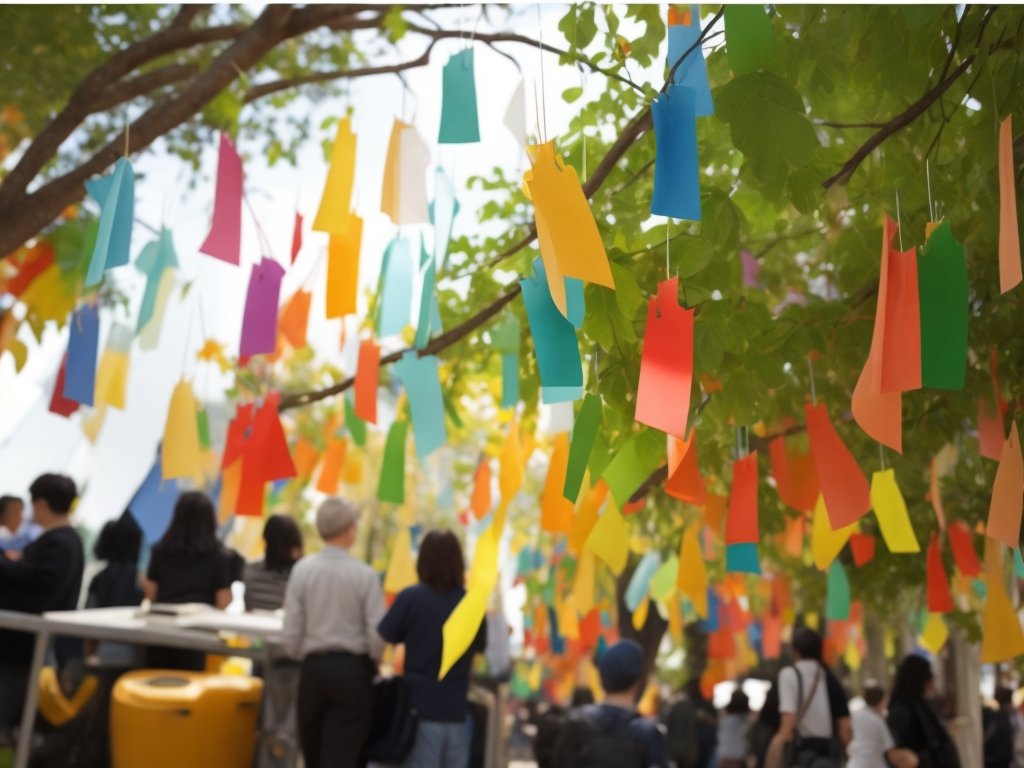Every summer, Japan lights up with a festival as romantic as it is radiant—the Tanabata Festival (七夕祭り). Known as the Japan Star Festival, this celebration brings to life a legendary love story between stars, decorating cities with colorful streamers, bamboo wishes, and celestial charm. Let’s dive into the traditions, origins, and vibrant ways the Tanabata Festival in Japan continues to enchant people today.
Table of Contents
ToggleOrigins and History of Tanabata
The Chinese Legend of Orihime and Hikoboshi
The roots of the Tanabata Festival lie in ancient Chinese mythology. The story tells of Orihime (織姫), a weaving princess, and Hikoboshi (彦星), a cowherd, who fell deeply in love. Distracted from their duties, the gods separated them, allowing them to meet only once a year—on the seventh day of the seventh lunar month. This tale, carried to Japan during the Heian period, forms the heart of Tanabata’s romantic spirit.
Introduction to Tanabata in Japan
In Japan, this story took on a unique cultural identity. Blending with local Obon customs and Shinto beliefs, Tanabata (七夕) evolved into a festival that not only celebrates love and stars but also personal aspirations and community spirit.
Adoption and Evolution Through the Ages
From imperial court rituals to bustling street celebrations in the Edo period, the Tanabata Festival in Japan has continually adapted, making it one of the country’s most cherished summer festivals.
When and Where Tanabata Is Celebrated
Main Dates and Calendars
Though traditionally held on July 7, the festival date varies by region, with some cities following the lunar calendar, celebrating in August instead. This flexible timing ensures a longer season for enjoying Tanabata (七夕) events across the country.
Famous Tanabata Festivals in Japan
Among the most famous are:
Sendai Tanabata Festival (仙台七夕まつり): The largest, featuring massive bamboo displays and streamers.
Shonan Hiratsuka Tanabata Festival (湘南ひらつか七夕まつり): Known for its elaborate paper decorations and street parades.
Local Customs and Regional Variations
From Okinawa to Hokkaido, each region brings a unique flair. In some areas, children float paper boats down rivers, while others hold fireworks or Bon Odori dances under the stars.
The Tanabata Myth and Celestial Imagery
The Story of the Star-Crossed Lovers
The lovers are represented by real stars: Vega (Orihime) and Altair (Hikoboshi). The Milky Way (天の川) divides them, echoing the mythical river of heaven they must cross to reunite.
Astronomical Elements and Symbolism
The Tanabata Festival invites people to look skyward, connecting dreams and wishes to the constellations. The night sky becomes a canvas for hopes—much like the colorful tanzaku (短冊) hung on bamboo branches.
Decorations and Festive Customs
Bamboo and Tanzaku Wishes
A defining custom is writing wishes on small colored papers, or tanzaku, and tying them to bamboo. The swaying of these paper-laced stalks in the summer breeze is a hallmark of Tanabata in Japan.
Traditional Decorations and Paper Crafts
Other popular crafts include origami cranes, kimono dolls, and nets symbolizing Orihime’s weaving.
Fukinagashi, Streamers, and Other Unique Adornments
Fukinagashi (吹き流し), long paper streamers, represent the threads Orihime weaves. In Sendai, massive fukinagashi hang like waterfalls of color above the streets.
Traditional Activities and Events
Wishes and Personal Reflections
People of all ages write wishes—not just for love, but for success, peace, and personal growth. It’s a deeply introspective and emotional part of Tanabata (七夕).
Cultural Events and Performances
Expect vibrant parades, taiko drumming, yukata fashion shows, and traditional dance performances—each echoing the story of star-crossed love.
Festive Clothing and Attire
Yukata and Seasonal Dress
Many wear yukata (浴衣)—light cotton kimono—to festivals. The patterns often feature morning glories (朝顔) or Japanese Maple (日本もみじ), enhancing the seasonal charm.
Cuisine and Food Stalls
Popular Street Foods
Like other matsuri (祭り), food is essential! Enjoy:
Takoyaki (たこ焼き) – octopus-filled dough balls
Kakigori (かき氷) – shaved ice with syrup
Yakitori (焼き鳥) – skewered grilled chicken
Taiyaki (たい焼き) – fish-shaped pastries filled with red bean
These treats are as much a part of the Japan Star Festival as the wishes.
Experiencing Tanabata in Modern Japan
Community Engagement and Spirit
Even in modern cities, Tanabata remains a time for togetherness. Schools, shopping arcades, and local communities craft their own bamboo displays and share their dreams.
Social Media and the Festival’s Visibility
Instagrammable streets, reels of floating lanterns, and AI-generated starry skies have made Tanabata Festival in Japan a rising trend among global travelers and influencers.
Tanabata’s Lasting Influence and Global Reach
Related Festivals and International Connections
Similar festivals are celebrated in Korea (Chilseok) and China (Qixi Festival). In Brazil and the U.S., Japanese communities host Tanabata festivals, spreading the myth of Orihime and Hikoboshi worldwide.
Final Thoughts
The Tanabata Festival (七夕祭り) is more than a celebration—it’s a bridge between myth and modernity, East and West, past and future. Whether you’re tying a wish to bamboo or gazing at the stars, you’re participating in a timeless tradition that brings hearts together across time and space.
You might love these too
Let’s Stay Connected!
Our newsletter brings you peaceful places, meaningful traditions, and unseen beauty.
You might love these too
Let’s Stay Connected!
Our newsletter brings you peaceful places, meaningful traditions, and unseen beauty.
You might love these too
Let’s Stay Connected!
Our newsletter brings you peaceful places, meaningful traditions, and unseen beauty.
